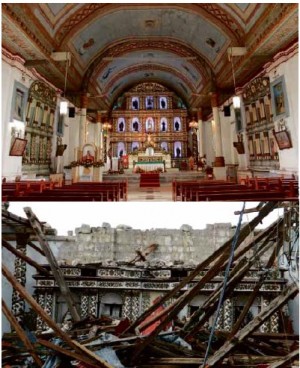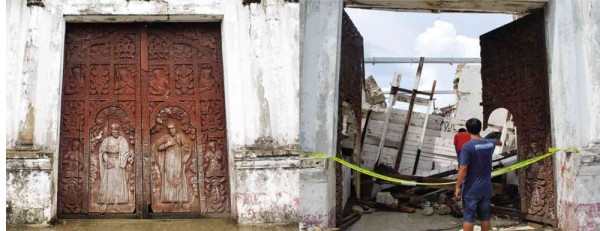

Typhoon “Yolanda” made first landfall at the town of Guiuan, Eastern Samar, devastating the town’s church of La Purisima Concepción, considered one of the finest and most beautiful Spanish colonial structures in the country.
Guiuan Church, one of the few in the country still with its original altars, carvings, painted ceiling and architecture still intact, is even more outstanding for being the only church in the country whose interiors are extensively decorated with natural shells embedded in the interior walls; this is documented in the publication, “Shell Ornamentation of La Purisima Concepción Church,” by Angel Bautista, published by the National Commission for Culture and the Arts, in 2003.
The church has completely retained its appearance from colonial times, complemented by having its ceiling painted in the 1930s by a certain GM Lucero and L. Monalola, who are fortunate to be named in church records.
Usually, the artists and craftsmen who labored to lavish churches with carved retablos and statuary, painted panels, stucco ornamentation and—outstandingly—shell ornamentation inlaid into the walls of the baptistery, have been anonymous.
Guiuan was one of the foremost choices among the 28 churches selected by the NCCA and the National Museum as National Cultural Treasures (NCT).
The National Museum is responsible for the care and maintenance of all NCTs. A team of qualified in-house conservation technicians and specialists attend to this task.
First images
National Museum consultant Orlando Albiñon provides us with the first images to be published that show the extensive destruction of the church. National Museum volunteer specialist Joel Aldor contributed images taken before the disaster.


Despite being heavily preoccupied with the wholesale destruction and damage to the country’s heritage structures in Bohol and Cebu from the October 15 earthquake, the National Museum was able to arrange a one-day trip for Museum technical consultant Orlando Albiñon to visit Guiuan.
Making the trip possible were the Balesin Island Club and Marco Diaz who, concerned with the state of cultural relics in Guiuan, provided a single seat in the light aircraft owned by the Club that was flying supplies to ravaged Guiuan.
The side altars of Guiuan church were in the process of restoration by National Museum technicians when the typhoon struck. However, after Yolanda, the National Museum’s work in Guiuan is expected to intensify. It must undertake a detailed assessment of the damage as a preliminary to determining the best restoration procedure.
In full transparency, the restoration shall be explained in detail to and agreed upon by the Diocese of Borongan, the parish and local community, and other stakeholders.
National Museum director Jeremy Barns assures, despite the ongoing work in Bohol and Cebu after the recent earthquake, that the National Museum can mobilize the support and resources to carry out and to complete their mission of caring for our cultural heritage that has been entrusted to them in behalf of future generations of Filipinos.
Although of primary importance at this period is to assist the survivors and restore normalcy, it is also time to pay attention to damaged heritage structures, so that the places which, for generations, have been the focus of local traditions, will be rebuilt.
Feedback and comments are invited to pride.place@gmail.com.

